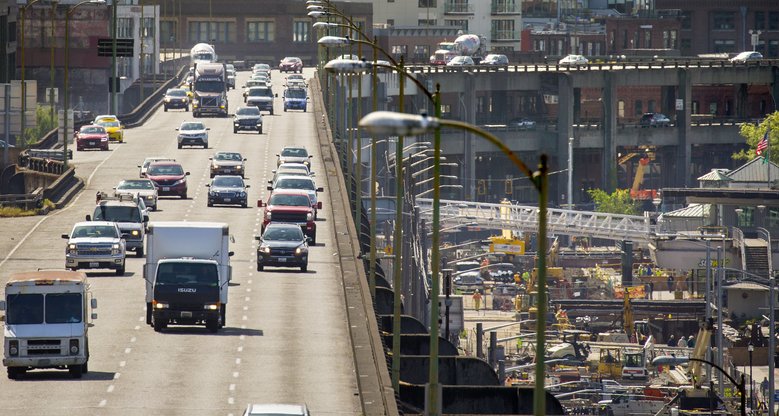By MIKE LINDBLOM
To avoid traffic jams during a two-week Highway 99 closure, Seattle-area commuters and truckers will start their shifts earlier — or work from home.
How does Seattle cope with a two-week traffic crisis?
By starting the business day at 6 a.m.
Eight downtown office buildings, including the 76-story Columbia Tower, will run their heating and ventilation two hours longer during the shutdown of the Alaskan Way Viaduct, to make the workday more flexible for as many as 15,000 employees and clients.
“The closure of the viaduct is definitely going to cause congestion,” said Patrick Callahan, CEO of the Urban Renaissance Group, which owns or manages the properties. “What can we do to help our tenants and employees manage this?”
So the official hours of 7 a.m. to 6 p.m. will temporarily be 6 a.m. to 7 p.m.
That’s just one way the region will shift its habits during the estimated two-week closure of Highway 99, from Belltown to the West Seattle Bridge, starting Friday. The shutdown is a precaution while the underground drill named Bertha digs the next 385 feet of the future Highway 99 tunnel under the viaduct.
Thousands will try a bus, train or water taxi. Some will work from home. Or spend more time in traffic.
INRIX, a global traffic-data company based in Kirkland, predicts a standard 15-minute trip from Sodo to downtown could double to 30 minutes when surface streets fill.
And in the north, most north-south commuter traffic will transfer onto Interstate 5, so trips there could take up to 50 percent longer from Green Lake to Highway 520, INRIX says. Its analyst recommends bypassing Seattle via Interstate 405.
King County government is encouraging its 13,000 employees to use networking software and video at home or outlying areas where that would improve productivity.
Mayor Ed Murray will allow many of the 10,000 city staff to make teleconferencing arrangements with department supervisors, so long as customer service and operating hours are maintained.
An estimated 3.3 percent of central-city employees telecommute, according to surveys by Commute Seattle, a nonprofit funded by government and business that encourages alternatives to solo driving.
Waterfront truck and tourist traffic will remain as busy as usual.
The Port of Seattle is adding a “hoot owl” shift from 3 a.m. to 8 a.m., before its conventional morning shift, to spread out container-truck arrivals at Terminal 46, the dock next to Bertha.
“We are encouraging all truckers to get their cargo in early, to avoid any of that normal rush-hour traffic,” said Port spokesman Peter McGraw.
Cruise ships will generate heavy traffic Saturday, May 7, when there will be one vessel at Terminal 91 and one at Pier 66 downtown. Each generates 5,000 vehicle trips from cabs, deliveries and charter buses.
“Every vessel takes on a ton of ice cream,” McGraw said.
When the shutdown known as Viadoom happened in 2011, to demolish the viaduct’s south end, drivers merged onto freeways as early at 4:30 a.m., while afternoon congestion spread as far as Lynnwood.
Driving fell by 20 percent, but this year there’s more overall demand and congestion, making all modes of travel fragile.
On the other hand, Sodo has three new overpasses, more express buses are coming from North Seattle, and light rail extends from the University of Washington to downtown and SeaTac.
This time, local governments have poured more workers, equipment and brainpower into preparing for the closure.
Two dozen Seattle police traffic officers will aim to keep intersections and bus lanes moving.
King County Metro Transit will pay 22 transit operators to drive 11 more buses than usual on weekdays, using state money. Those buses will be on standby to relieve routes that become delayed, not only the detouring viaduct lines but Route 5 from Greenwood, and the E Line from Shoreline and Aurora Avenue North.
Seattle Department of Transportation will post seven portable message signs, from Northgate to Delridge, along with its 34 permanent signs.
Public awareness is greater compared with 2011, said Jessica Szelag, executive director of Commute Seattle.
News reports are paying more attention to telework, transit, rideshares and bicycling options, she said. People have more smartphone tools to look at traffic maps and transit apps.
The Downtown Seattle Association announced a #whyrushhour radio and social-media campaign, featuring chefs Thierry Rautureau and Tom Douglas, suggesting that workers linger through the evening to eat, shop or play.
Only 31 percent of central-city commuters in downtown, First Hill and South Lake Union drive alone. Friday’s closure gives people a chance to shake up their routines, Szelag said, and perhaps make a long-term change.
May 1 marks Bike Everywhere Month, and on Monday morning, a new bicycle-counter totem will open in the Second Avenue bike lane.
It’s not only commuters who must plan. On Saturday, a March of Dimes walk, Sounders match and Mariners game will fill downtown streets. On Sunday, there’s another baseball game — as well as May Day demonstrations.
Photos by Mike Siegel/The Seattle Times
